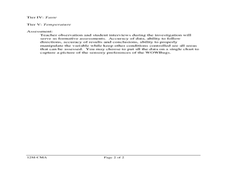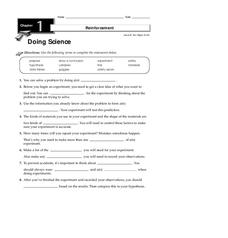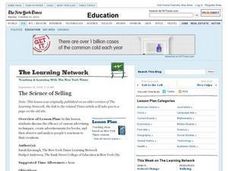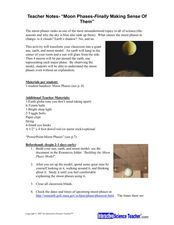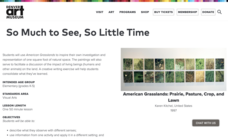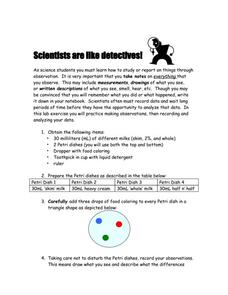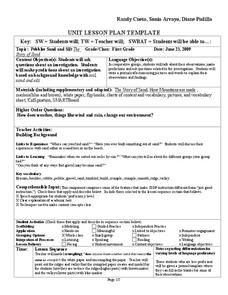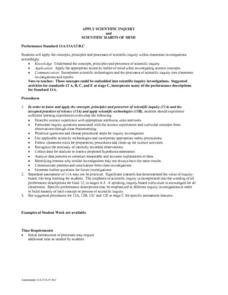Curated OER
Chemosynthesis for the Classroom
Explorers set up Windogradsky columns with local mud so that they can culture microorganisms. After three and six weeks they make observations of the mud and the organisms growing in it. In this way they observe succession and relate...
Curated OER
Why did the can crush?
Students watch a demonstration to ascertain why a soda can crushed. They make observations and hypothesize about why a soda can crushed and relate the difference in pressure to its affect on objects around us (soda can). Explanation is...
Curated OER
The Nature of Science and Technology
Second graders perform a variety of experiments to observe, form conclusions, and make inferences. In this experiment lesson, 2nd graders experiment based on the result of a pre-assessment. Students share what they have learned.
Curated OER
Doing Science
In this science experiment process worksheet, students will learn about the steps of conducting a science experiment, including creating a hypothesis, collecting data and drawing a conclusion. This worksheet has 8 fill in the blank...
Curated OER
Sunny Science - Sun Up, Fade Out
Learners create bleached designs with the sun's bright light. In this early childhood science lesson, students use their observation and prediction skills as they explore the sun's bleaching power.
Curated OER
Designing a Germination Experiment
Students explore botany by participating in a seed experiment. In this plant nutrition lesson, students define several science experiment vocabulary terms like observation, treatment, and replicate. Students utilize soaked seeds in a...
Curated OER
The Science of Selling
Students discuss advertisements and techniques they have discovered. They read an article about the science of selling and create an advertisement of their own to sell a book. They record people's reactions to their advertisement and...
Curated OER
Science Workshops
Based on the popular Writer's Workshops used in language arts, Science Workshops can be used to teach both science content and process.
Curated OER
Moon Phases - Finally Making Sense of Them
Young scholars investigate the different phases of the moon. In this lunar cycle lesson, students create models of the sun, earth and moon and investigate why we observe the moon the way we do. Young scholars observe a...
Curated OER
The Dose Makes The Poison
High schoolers observe beakers of water that contain different amounts of a mystery chemical. They discuss how each amount of the chemical might affect them if the chemical was beneficial or harmful to their bodies.
Curated OER
Make Your Own Compass
Learners explore magnetism. In this "magnets" science lesson plan, students make a compass with common household items and explain the relationship between what a compass does and the earth's magnetic fields.
Curated OER
Science Current Events Lessons
You can use current events to increase student understanding of both science concepts and language arts skills.
Curated OER
How Do You Make A Tornado?
Students create a tornado in a bottle. In this climate and weather lesson plan, students review basic information about tornadoes and thunderstorms. Students make a tornado in a bottle and write about what they learned from the project....
Curated OER
The Scientific Method
If the steps that you follow for the scientific method are as follows, this presentation can be useful: observation, question, hypothesis, method, result. Unfortunately, not every scientist or teacher uses the same terminology, The...
Curated OER
One Sweet Experiment
This resource is designed to be used as a lab sheet when experimenting with the dissolution of sugar in water. It's very nice in that it follows the scientific method of experimentation. There are places for the definition of the...
Curated OER
States Of Matter
Delv into the states of Matter. Students engage in the scientific inquiry process to uncover the exciting world of Matter. They watch a series of videos, and conduct experiments in order to collect and analyze data on the various state...
PBS
NOVA Sun Lab Lesson Plan
Looking for a sun-sational multi-lesson plan full of videos, simulations, and discussion? Introduce your young scientists to all things solar with a four-part hands-on adventure. Pupils learn the basics of solar anatomy, space weather,...
Denver Art Museum
So Much to See, So Little Time
How do humans and animals impact the environment? What is land division? Youngsters tape off a 12x12 inch square in an outdoor natural space. They sketch everything they see, then compare their drawings as a class. They will then be...
Royal Society of Chemistry
Acids and Bases—Microscale Chemistry
Here's proof that small-scale labs lead to big-time learning. Introduce acid-base interactions to middle school scientists through a microscale chemistry lab. Pupils combine a variety of solutions and use indicators to obtain approximate...
Curated OER
Scientist Are Like Detectives
Students demonstrate proper scientific observation skills. For this investigative science lesson, students make observations, record their findings and form conclusions in order to improve their scientific documentation and writing skills.
Curated OER
Unit Lesson Plan Template
First graders listen to the book The Story of Sand and make predictions about an investigation based on soil, sand, and silt. In this sand lesson, 1st graders work in groups to discuss their observations about sand and answer higher...
Curated OER
Apply Scienctific Inquiry and Scientific Habits Of Mind
Students describe science experience with appropriate attributes, units, and tools. They formulate inquiry question associated with the science experiences and curricular concepts from observations through class brainstorming. Pupils...
Curated OER
No Creation-No Destruction--All in a Baggie
Students investigate the concepts of conservation of mass and simple chemical reactions. Students complete lab experiments and record all observations as well as conduct experiments on their own to determine which reactions created...
Curated OER
Weather Maps and Prediction
Second graders point out symbols for high and low pressure that would be found on weather maps. They break into small groups and use a copy of the weather maps file to make observations about the maps and come up with an explanation of...


